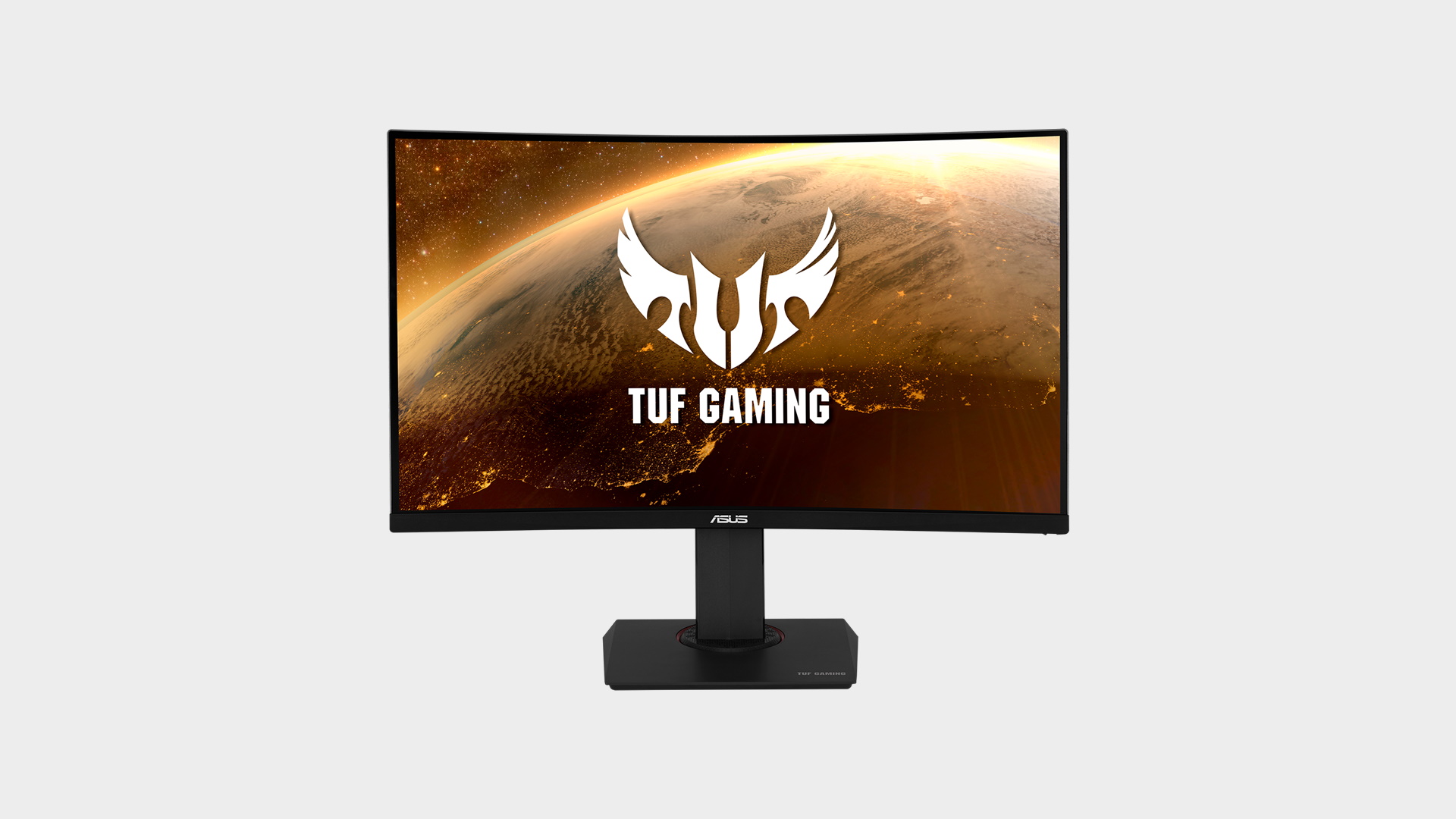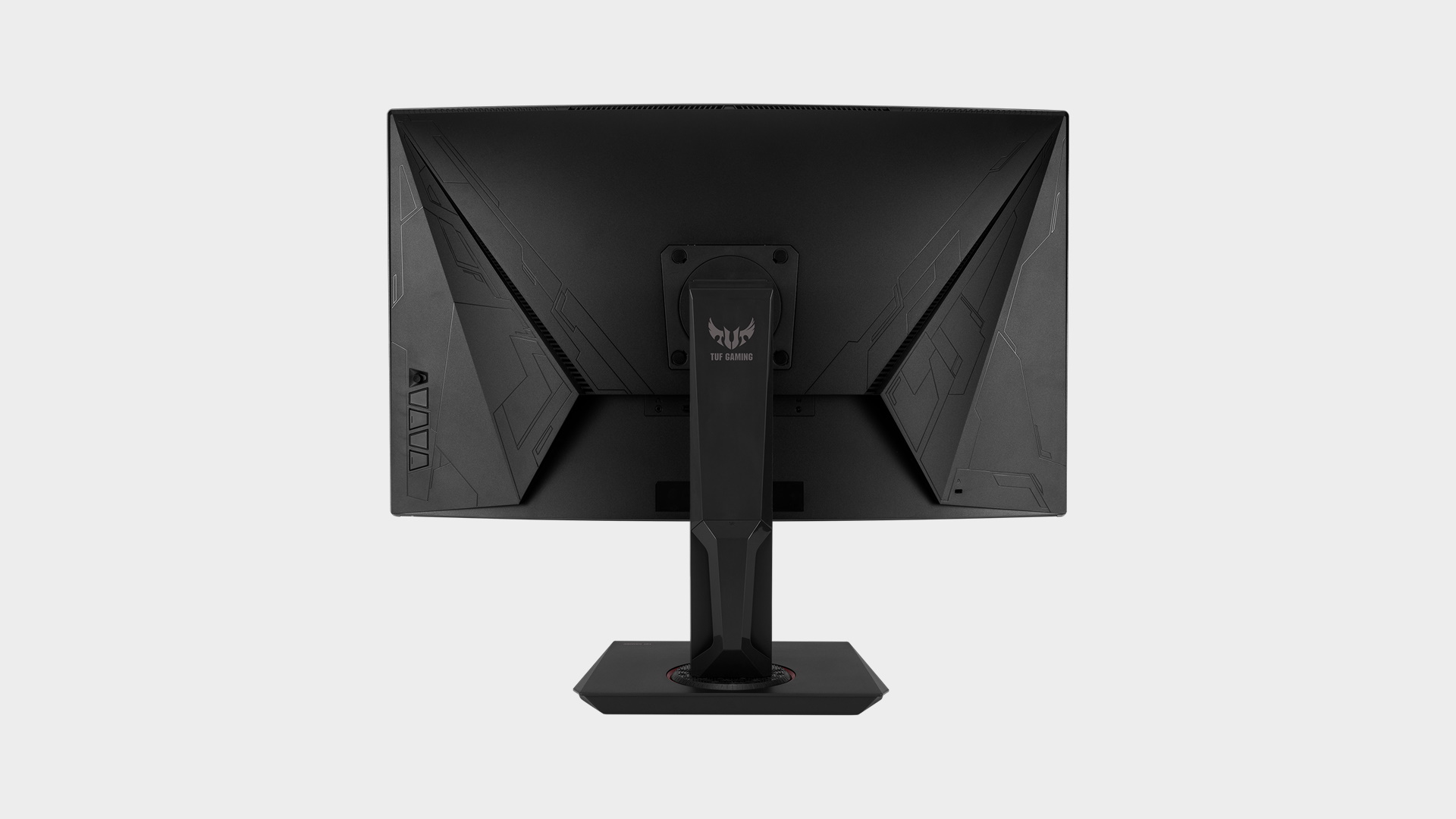Our Verdict
The Asus TUF Gaming VG32VQ drops all the unnecessary gamer aesthetics and doubles down on great features for PC and console gaming.
For
- Punchy, vibrant color
- Adaptive and ELMB Sync
- Wallet-friendly
Against
- Color accuracy
- No USB
- Basic design
PC Gamer's got your back
Modern gaming monitors have become overly complicated beasts that set out to be everything to everyone; from hardcore gamers to precision colorists. This inevitably leads to compromises or absurdly high asking prices. This is why I like the ASUS TUF Gaming VG32VQ. This $400 32-inch curved monitor focuses on the essentials and not fancy feature lists or outlandish designs. The VG32VQ is laser-focused on PC gamers and console owners who want a single monitor for their gaming.
Size: 31.5-inch
Resolution: 2560 x 1440, 16:9
Panel: VA
Refresh: 144Hz
Response: 1ms
HDR: HDR10
Adaptive Sync: AMD FreeSync
Special Features: ASUS ELMB Sync, GameVisual
MSRP: $420 (£429 / AU$599)
To that end, ASUS has equipped the VG32VQ with only three video inputs: a pair of HDMI 2.0 ports for consoles and a DisplayPort 1.2 for high-speed PC gaming. The monitor also has built-in speakers, but the less said about those the better. Best to stick with headphones via the built-in headphone jack. The VG32VQ also supports HDR10, a standard more commonly found in TVs than gaming monitors. This means your Xbox One/Series X|S and PlayStation 4/5 consoles will recognize the VG32VQ as an HDR capable display—something plenty of HDR monitors fail at.
And even though the large 32-incher is curved, at 1800R it's so slight that it's easy to forget that it is. Viewing angles are great with just a hint of color washout at extreme angles. The stand is a solid pillar sitting on a polygonal base and while it won't win any design awards, it certainly keeps the heavy panel securely in place with no wobble. You can adjust the monitor's height, tilt, and swivel but there's no rotation. The overall aesthetic is pretty utilitarian, made from durable plastics and nary and RGB light in sight.
The OSD menu buttons are the biggest, chunkiest sort I've ever encountered on a monitor. They are easy to find without the usual fiddling with fancier monitors. They are packed close together but thanks to alternating heights, you can easily distinguish between them. I'd still prefer they were located on the bottom bezel which would make them easier to access and especially for lefthanders.
The OSD menu itself is easy to navigate, with the different picture settings and game enhancement features all logically laid out. You can also create and save up to four personal picture profiles, though I couldn't find any way to assign them to the quick actions associated with pressing the menu buttons. That would have saved me the tedium of trying to do simple tasks like change brightness or input.
The VG32VQ features a VA panel with a native 1440p resolution. The first thing I noticed was the contrast and saturation. The 3,000:1 contrast ratio may not sound like much but it's decent enough, and with 400 nits of max brightness, everything looks punchy and vibrant. Too much so in fact. I wouldn't recommend this monitor for any sort of color-accurate work.

I also couldn't really calibrate it to get a color profile that I trusted, but since I enjoy the saturated, contrasty look, I can live with it. Games look visceral but the dark areas of the picture suffer—losing a fair bit of detail. This can be detrimental in darker-themed games like Remnant Ashes that I've been playing recently. Thankfully, there's a Shadowboost option that works fairly well at brightening the dark spots.
The monitor gives you a number of picture profiles which it calls GameVisual. These adjust contrast, saturation, and Shadowboost for different genres of content (not just games). I mostly stuck with Cinema mode for gaming which gives the vibrancy without crushing the darks as much. There's an sRGB mode which I assume is for professional/productivity work but I wasn't happy with the color presentation. Annoyingly, you can't access GameVisual when running HDR on consoles.
But most PC gamers could care less about all that HDR jazz. Refresh and response are king and while the 144Hz refresh is pretty old school these days, it works splendidly. Adaptive Sync games run beautifully at higher framerates too. Asus also includes its proprietary Extreme Low Motion Blur or ELMB Sync tech which works in tandem with Adaptive Sync to judiciously remove any blurring. Using the UFO test (www.testufo.com), I saw how effective ELMB Sync is at smoothing out blurry images.

I tested the VG32VQ with an NVIDIA GeForce RTX 3070 running adaptive sync. Playthroughs of Apex Legends, Fortnite, and Doom Eternal all easily hit 160-190fps with no tearing, stuttering, or ghosting. If you play competitive shooters like Valorant or CS:GO, this monitor won't let you down.
The ASUS TUF Gaming VG32VQ is a great budget monitor that I've enjoyed playing all sorts of PC and Console games on. I certainly don't recommend this to anyone who needs to do any work that requires color accuracy. And the lack of USB ports is a bit of a downer, but at $400, it's rather TUF to find a better 32-inch curved monitor with HDR10 and ELMB Sync.
If this isn't quite what you've been looking for, be sure to check out our guide to the best gaming monitors.
The Asus TUF Gaming VG32VQ drops all the unnecessary gamer aesthetics and doubles down on great features for PC and console gaming.
Kizzy is the consummate geek, with black turtleneck design sensibilities, always on the hunt for the latest, greatest, and sexiest tech. He's played Doom on the OG Pentium and still remembers how to hack a dial-a-phone. After four decades of being crazy about tech, he's literally just getting started. It's the age of the geek, baby!



